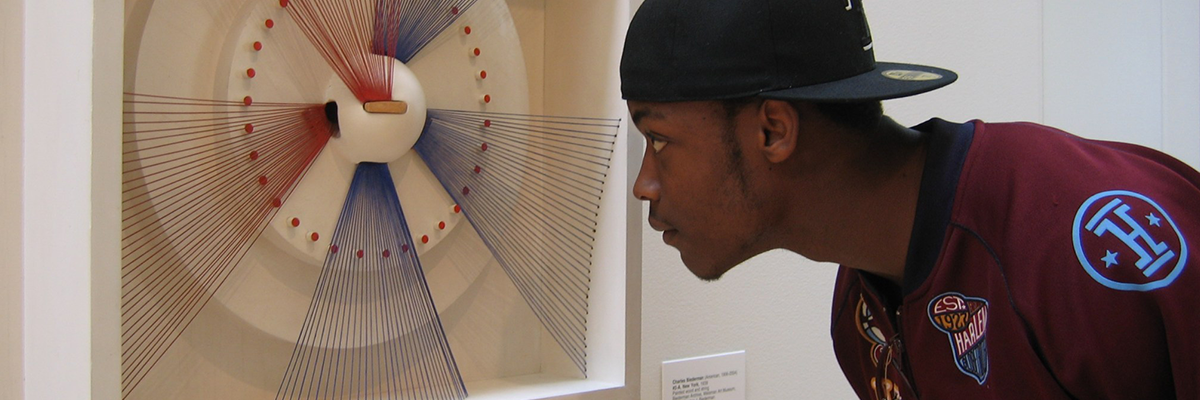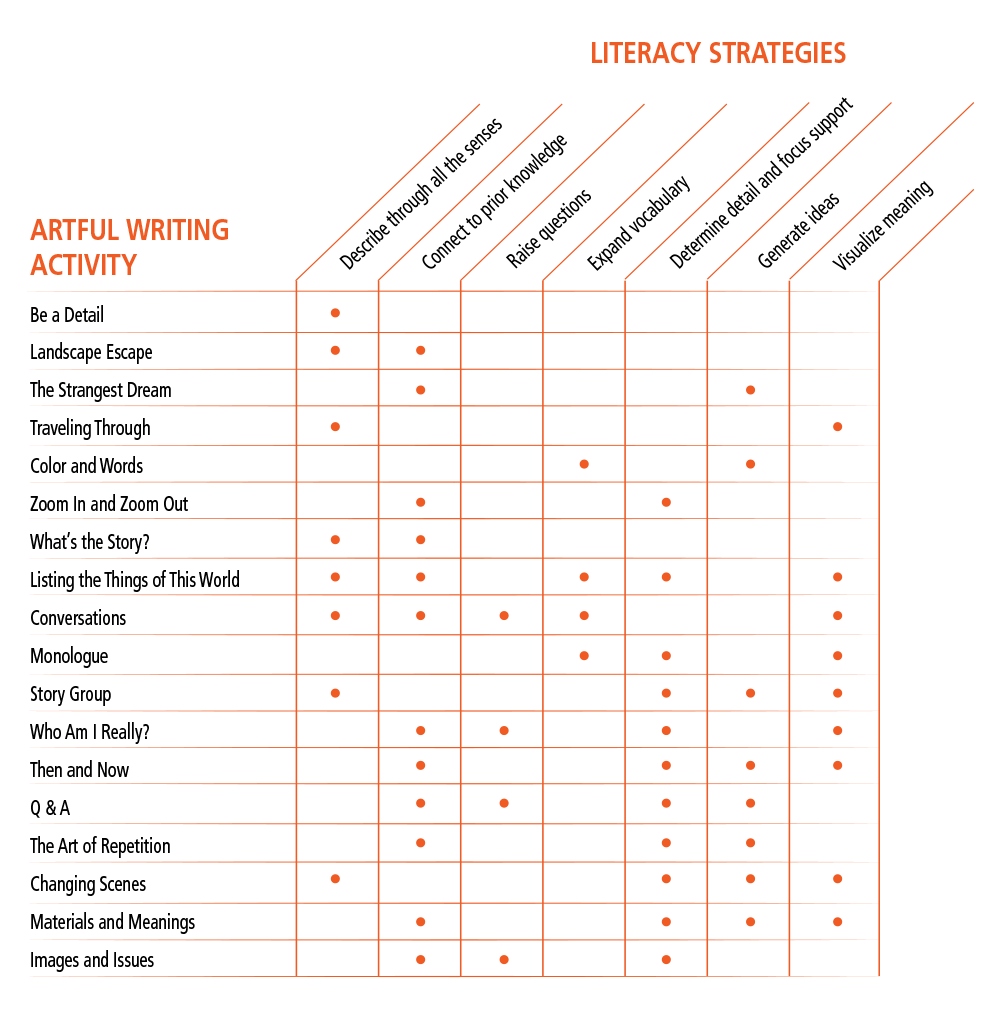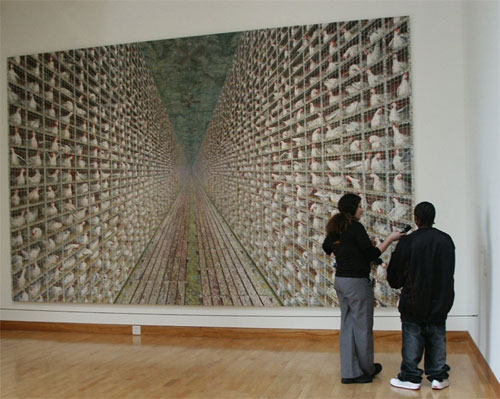
Artful Writing is centered on works of visual art. The images offer rich puzzles to investigate. The PERCEIVE cards guide students into a work and help them begin to build meaning. By practicing the habit of increased perception — slowing down to look before judging — students find evidence to help build their interpretations and opinions and gain an awareness of, and confidence in, their own thinking.
Increased observation or sensory perception—taking time to notice things that others might miss—is an essential practice in visual literacy and a valuable skill for all learners and creative thinkers.
Both this web-based resource and the printed Artful Writing Classroom Resource Kit include a range of art images and writing activities for students and teachers to choose from. Most activities work well with more than one of the reproductions, or images you may already have. All of the writing and creative activities follow the same process:
1. Perceive 2. Consider 3. Create 4.Reflect
Students are challenged to practice careful observation, connect with prior knowledge and personal experience, express ideas, and reflect upon the quality of their work.
Activities by Grade
Grade 4 through 12
- Be A Detail
- Color and Words
- Landscape Escape
- Listing the Things of the World
- The Strangest Dream
- Traveling Through
- What’s the Story
- Zoom In and Zoom Out
Grade 7 through 12
- Changing Scenes
- Conversations
- Monologue
- Q & A
- Story Group
- The Art of Repetition
- Then and Now
- Who Am I Really
Grade 9 through 12
Which activities will work best in my classroom? How do I choose?
Choose activities that will support your students’ learning and energize your curriculum. Of course, we encourage you to adapt any activity of interest to meet your students needs and goals.
What key literacy strategies do the Artful Writing activities help support?
The following chart cross-references the eighteen Artful Writing activities with fourteen strategies that help build comprehension and literacy. Following the card directions, students will generally engage in several key strategies—careful observation, connecting to prior knowledge and emotions, building vocabulary and fluency, making meaning, and reflecting as their working process. Each of the activities also intentionally targets specific literacy strategies in more depth.

PERCEIVE Cards & Questions
The PERCEIVE cards guide the essential underlying process of careful observation or perception. The cards are intended for use with the accompanying visual art images, but this process may be useful with other forms of text as well.
![perceive. before you read anything about the image, use your powers of observation to look slowly and closely. [eye image] what do you notice? imagine using all of your sense. what do you recognize? [star image] what feeling do you get from the image? is there a mood? [puzze piece image] what does this image remind you of? what is going on? what other meanings could there be? [question mark image] what does the image make you wonder about? what more d you want to know?](/sites/wam.umn.edu/files/2023-04/perceive.gif)
PERCEIVE steps:
- What do you notice? Imagine using all your senses. What do you recognize?
(SLOW down. To guide looking, paraphrase student remarks and check understanding. Point to details mentioned. List and take inventory) - What does this image remind you of? What is going on? What other meanings could there be?
(Reveals students’ prior knowledge and honors their experiences. Can prompt metaphoric thinking. Follow with, “What do you see that makes you say that?”) - What feelings do you get from the image? Is there a mood or tone?
(These can be the most challenging responses to express. Follow with, “What has the artist done to create those feelings?”) - What does the image make you wonder about? What more do you want to know? What questions does the artwork raise?
These questions lead to the viewer’s thoughtful speculation about what the artwork might mean. Getting started requires only the image or text being investigated and the viewer’s prior knowledge and experience. It provides the steps to begin to tackle any artwork, no matter how daunting!
Working through the perception process can be done individually, but it can be particularly effective as a guide to facilitate group discussion. Sharing perceptions, responses, and questions about a single work can be dynamic and rewarding whether the dialogue is between partners or in the facilitated discussion of a larger group. Puzzling out meanings from a rich image, students build on each other’s ideas. Use the steps to facilitate the investigation of a dense poem, work of literature, or an artwork in any other discipline. Make this inquiry strategy a habit in your classroom.
Follow with artful writing activities, art making, research or further inquiry framed by the questions, issues, or topics generated.
In Practice
Educator Melissa Borgmann and student Alston Riley discuss the meaning of a painting in the Weisman’s galleries using the PERCEIVE questions. Alston describes “Untitled”, a painting by Douglas Argue exhibited at the Weisman Art Museum, lent by the Gerard L. Cafesjian Collection, Naples, Florida.

Why It Works
Artful Writing’s Big Idea
Students will learn that both art and writing are based on communicating ideas. Both provide meaningful opportunities to heighten perception, engage emotions, deepen thought, and broaden one’s understanding of the world.
Through the practice of inquiry-based writing, reading, art viewing, and art-creating activities, we hope that students find an enduring understanding of the value and power of both art and writing to express ideas. The collaborative authors of this resource used tools from the Artful Teaching and Learning Handbook to develop the program resources. The Artful approach encourages teachers to continuously review their teaching process and define the teaching and learning that really matter.
Designing backwards, we were able to articulate the “big idea” that would guide the creation of our resource materials. It is our hope that the resource materials will serve you well as you draw upon them to create curriculum and learning goals that match your students’ needs.
What is the value of exploring the processes that visual art and writing share?
Works of art are complex visual objects that invite multiple interpretations. Thinking about and writing from art is an excellent way to engage students in high-level thinking practices, such as reasoning, perspective-taking, problem-finding, and making metaphors. These thinking skills cross disciplines.
For many students, visual images are more immediately accessible than text and may provide a valuable link to engaging them more thoughtfully, critically, and creatively during the process of writing. With Artful Writing they are challenged to build their own reasoned interpretations of visual artworks. Students often connect with images on an emotional level. When they are given an opportunity to express their unique views and ideas, there exists a powerful motivation for capturing and expressing ideas through meaningful and articulate writing.
For visual art teachers, thinking and writing about art offers new processes and approaches to involve students in finding meaningful issues and subjects to express visually. Both art and literature are about ideas. The parallel creative processes of artists and authors can be used to support the creative expression of both disciplines. Successful reading strategies parallel the strategies used by viewers puzzling meanings from a work of visual art. Teaching students to comprehend more deeply and critique texts, both visual and verbal, is critical to the teaching of literacy, art, and writing.
Some essential questions for students to explore
- What do viewers and readers do to make meaning from images or text?
- What do artists and authors do to create meaning from images or words?
- What is literacy and how do you become literate?
- What is art for?
These are broad questions that guide the design of the Artful Writing activities and workshops. The Artful Writing Classroom Resource Kit is not a curriculum of set, sequenced lessons. Instead, it is a creative tool for writing and art teachers that provides strategies for helping students explore these related channels of inquiry. Teachers are encouraged to use the learning activities to challenge the writing level of their students and meet their unique curricular needs.
Some essential questions from and for teachers
- How can I help students perceive more?
- How can I help students build meaning instead of just “receiving” it?
- How can I help students to create work that is meaningful to them?
- What does literacy look like?
These are just a few questions raised by collaborating teachers from all disciplines when reflecting upon their teaching strategies and ways of addressing gaps they’ve identified in their students’ learning. They may help you work with this and other resources, selecting and designing the sequence of activities and projects that meet your identified learning goals and demonstrates your students’ learning.
Investigating art can stimulate critical thinking as reasoning, metaphor finding, perspective shifting and question finding. But how do students “get into” it?
Using the PERCEIVE card, based on Critical Response questions, can help viewers start interpreting a work of art (or any text). Use of Critical Response and creating a “thinking routine” of these questions in your classroom is a way to help make critical thinking more explicit and visible to students, and to support the transfer of these skills across subject areas. Use these questions to guide individual student response or to frame group discussions.
As a teacher, capturing group responses on the board, or paraphrasing student remarks can help keep the discussion going. Following up student responses with “what do you see that makes you say that?” pushes students to practice reasoning and dig deeper into visual evidence.
Why is the process of perception the starting point for all other activities?
Artists and writers use their powers of observation to notice things that others might not notice.The PERCEIVE card guides the essential underlying process of careful observation or perception. This pop up card is intended for use with the accompanying visual art images, but this process may be useful with other forms of text and as a guide to student reflection on their own work, or the work of peers.
We have adapted this process from other successful sequential, critical approaches with which you may be familiar. Ours places emphasis on sensory response, emotional connection, and connecting with personal memory. Increased observation or sensory perception—taking time to notice things that others might miss—is an essential practice in visual literacy and a valuable skill for all learners and creative thinkers.
Relevant Artwork
- Berenice Abbott: Murray Hill Hotel, 1935
- Eugène Atget: Men’s Fashions, 1925
- Thomas Hart Benton: The Boy, 1948
- Charles Biederman: Untitled, Paris, April 1937
- Isabel Bishop: Noon Hour, 1935
- Hyman Bloom: Untitled (The Boxer), about 1935
- Cameron Booth: Red and Blue, 1962
- Julie Buffalohead: Nanabozho and Coyote’s War Party, 2000
- Alexander Corazzo: Untitled #10, 1936
- Joseph Cornell: Untitled (Big Ben), 1972
- Arthur Dove: Gale, 1932
- Lyonel Feininger: Dröbsdorf I, 1928
- Bernard Frize: Paradisio, 2000
- Anthony Green: The Picture Maker, 1968
- Robert Gwathmey: Nobody Around Here Calls Me Citizen, 1943
- Marsden Hartley Portrait, 1914-15
- Marsden Hartley Landscape No. 36, 1908-09
- Lewis Hine Young Boy Coal Miner, 1909-13
- Edward Hopper: Night Shadows, 1921
- George Inness: Moonlight, 1885
- Wesley Kimler: Hunter/ Prey, 1985
- Jacob Lawrence: Dancing Doll, 1947
- Roy Lichtenstein: World’s Fair Mural, 1964
- Hung Liu Miss Fortune, 1995
- Stanton Macdonald-Wright: Synchromy #3, 1915-1916
- Alfred Maurer Girl in White, c. 1901
- Ruth Morgan: Percenda, 1995
- B.J.O. Nordfeldt Green Woods, 1950
- Simon Norfolk: Teahouse, Afghanistan, 2001
- Georgia O’Keeffe: Oak Leaves, Pink and Gray, 1929
- Judy Onofrio: Big Catch, 1996
- Judy Onofrio: Madame Twisto, 2002
- Luis González Palma: Juan, c. 1998
- James Rosenquist: World’s Fair Mural, 1964
- Paul Sample Western Landscape, 1930–38
- Sandy Skoglund: Parallel Thinking, 1986
- Xavier Tavera: Enmascarado I & II, 2003
- Star Wallowing Bull American Dreamers, 2000